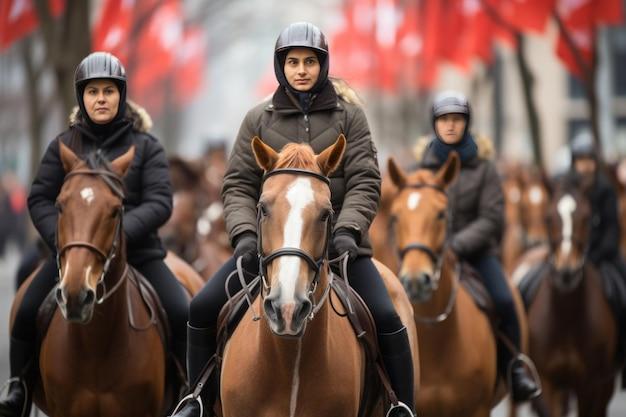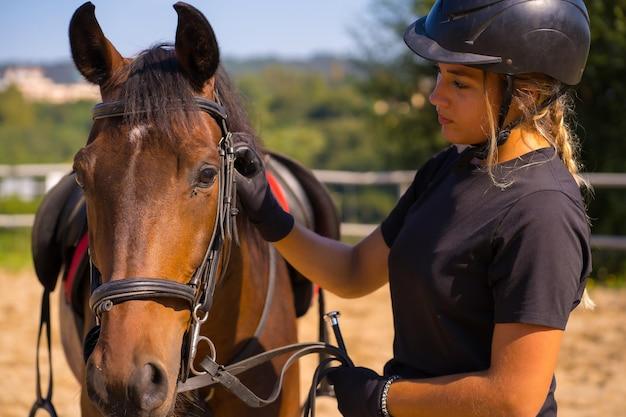Horseback riding is a popular recreational activity that provides a unique sense of freedom and connection with nature. Whether you are a seasoned equestrian or a beginner, you may have noticed that while riding a horse at certain gaits, there is a rhythmic bouncing motion that occurs. But have you ever wondered why horseback riders bounce up and down?
In this blog post, we will delve into the reasons behind this phenomenon and explore the factors that contribute to the bouncing motion experienced while riding. We will also address common questions and concerns related to horseback riding, such as whether it is painful, why horses hold their tails up, and how to prevent excessive bouncing. So, saddle up and let’s dive into the fascinating world of horseback riding!

Why Do Horseback Riders Bounce Up and Down?
Riding a horse can be an exhilarating experience, but for those unaccustomed to it, the bouncing up and down motion can feel like riding a makeshift roller coaster. You might find yourself wondering, “Why do horseback riders bounce up and down?” Well, my curious friend, I’m here to shed some light on this bouncy mystery.
The Galloping Gait: A Frenzied Frolic!
When a horse is trotting or galloping, its legs move in a synchronized pattern known as the “diagonal gait.” It’s a bit like a dance routine, where the horse’s front right leg moves in conjunction with its rear left leg, and vice versa. This alternating action propels the horse forward, allowing it to cover large distances with impressive speed.
The Motion of the Ocean… I Mean Horse
As a horse transitions from a walk to a trot or gallop, the motion becomes more pronounced, and that’s when the bouncing begins. You see, my dear reader, a horse’s back rises and falls with each step, creating an up-and-down motion that transfers to the rider. It’s like being on a seesaw, just with a majestic equine twist!
The Tension Unleashed: Absorbing the Shock
To stay in rhythm with their trusty steeds, skilled riders employ a technique called “posting” or “rising trot.” By using their leg and core muscles, riders lift themselves slightly off the saddle during each upward movement of the horse’s back. This action helps absorb the shock and reduce the impact, sparing their spines from feeling like a trampoline.
Stirrups: A Rider’s Anchors
Stirrups are not just fancy-looking accessories for equestrians; they serve a crucial purpose. These metal loops attached to the saddle allow riders to secure their feet, providing stability and leverage. When trotting or galloping, the rider’s weight is distributed through the stirrups, helping them maintain balance and minimizing the bounce.
Saddle, Saddle, Saddle up!
Now, let’s talk about the unsung hero of horseback riding – the saddle. A well-designed saddle helps distribute the rider’s weight more evenly across the horse’s back, reducing the impact on both parties. The cushioning provided by the saddle’s foam and leather combination also plays a crucial role in dampening the vibrations experienced by the rider.
A Jiggly Yet Jolly Ride
So, my curious friend, the bouncing up and down motion experienced by horseback riders may initially seem like an odd phenomenon. However, it’s simply a result of the horse’s galloping gait and the rider’s need to synchronize with it. With clever techniques like posting and the aid of stirrups and an ergonomic saddle, horse enthusiasts can make their jiggly journey an enjoyable one!
So, the next time you see a horseback rider gracefully navigating the bounce, remember the intricate dance between horse and human. It’s a synchronized frolic that captures the essence of the equestrian experience. Happy riding and enjoy the jiggles!

FAQ: Why do horseback riders bounce up and down?
Welcome to our FAQ section, where we’ll address all your burning questions about why horseback riders bounce up and down. Let’s dive right in and demystify this phenomenon!
Is horseback riding painful
While horseback riding can be physically demanding, it shouldn’t be painful. Discomfort may occur if you’re not properly positioned in the saddle or if you have any pre-existing back issues. However, with proper technique and a well-fitted saddle, riding should generally be a smooth and enjoyable experience.
Why do horses hold their tails up
You may have noticed horses holding their tails up while riding, and it’s not just for show. When horses lift their tails, they are often expressing excitement or anticipation. It’s their way of saying, “I’m ready to go!”
Why do jockeys bounce
Ah, the bouncy jockeys! Jockeys bounce on purpose when riding at high speeds, such as during a gallop. This bouncing motion helps them maintain balance and stay in sync with the horse’s movements. It may look amusing, but it’s a skill they’ve mastered through years of practice.
How do I stop bouncing when riding a horse
If you’re bouncing more than you’d like, fear not! Improving your riding posture and core strength can work wonders. Engage your abdominal muscles, relax your hips, and practice moving with the horse’s motion rather than against it. With time and practice, you’ll find yourself bouncing less and gliding more.
Are you supposed to bounce when riding a horse
Bouncing is a common challenge for beginner riders, but here’s the good news: You’re not supposed to bounce like a rubber ball. With proper form, balance, and a harmonious connection with your horse, you should be able to achieve a smooth and coordinated ride. So, hang in there, keep practicing, and soon you’ll be bouncing-free!
Do horses’ backs hurt when you ride them
When properly cared for and provided with a well-fitted saddle, horses’ backs should not experience pain from riding. However, it’s essential to be mindful of proper saddle fit, distribution of weight, and regular veterinary check-ups to ensure your noble steed remains comfortable and happy under saddle.
What’s faster, a canter or a gallop
Hold on tight, because here’s the need-for-speed answer! A gallop is faster than a canter. A galloping horse can reach breathtaking speeds of up to 35-40 miles per hour, making it the ultimate rush for both horse and rider. Just make sure you’re experienced and ready to handle the adrenaline-fueled adventure!
Does riding a horse hurt your “nether regions”
Ah, the delicate question! When riding, especially for extended periods, some riders may experience discomfort in their “nether regions.” However, fear not, brave equestrians! Investing in padded riding shorts or opting for a well-padded saddle can help alleviate any discomfort and keep your ride pleasant.
Does it hurt to ride a horse without a saddle
Riding without a saddle can indeed be a bit rough on your rear end, as you’ll be feeling the horse’s movements directly. However, some seasoned riders enjoy the close connection and increased balance that comes with bareback riding. Just be prepared for a more intimate (and potentially bumpy) ride.
How does it feel to ride a horse
Ah, the million-dollar question! Riding a horse is a unique experience that can’t be fully described until you’ve felt it yourself. It’s a tantalizing blend of freedom, power, and grace as you communicate with your equine partner. The rhythmic sway of their movements beneath you is both thrilling and calming—a truly magical connection between rider and horse.
Why do horses push you with their heads
When horses push you with their heads, it’s their way of showing affection and seeking comfort. It’s like a gentle nudge saying, “Hey, I like you.” So, embrace the nuzzles, scratches, and pats—they’re gestures of trust and companionship from these incredible creatures.
Why is horse riding so hard
Ah, yes! Horse riding can be challenging, but that’s part of its allure. Balancing your body, coordinating your movements, and communicating with a powerful animal requires patience, practice, and perseverance. But fear not, intrepid equestrians! With time, dedication, and a sense of humor, you’ll conquer the challenges and triumph over the saddle.
How long does it take to learn to canter on a horse
Learning to canter is an exciting milestone in any rider’s journey, but it can vary from person to person. While some may master it in a few weeks, others may take a few months to feel confident and comfortable in the canter. Remember, it’s not a race—enjoy the process and savor each step along the way.
How do you not bounce in the canter
Ah, the elusive quest for a smooth canter! To reduce bouncing, focus on relaxing your seat and allowing your hips to follow the horse’s motion. A strong core and flexible joints also play a significant role. Practice, practice, practice, and soon you’ll be cantering with grace and elegance, leaving the bounce in the past.
Why are horse saddles so heavy
Ah, saddle up for the scoop on saddle weight! Horse saddles are typically heavy because they are designed to provide support, stability, and balance. The weight helps distribute the rider’s weight evenly across the horse’s back, ensuring comfort and reducing pressure points. So, think of it as a necessary trade-off for a cozy and secure ride.
Do horses know when they win a race
While horses may not comprehend winning a race in the same way humans do, they are incredibly perceptive animals. They can sense the excitement of the crowd and the elation of their jockey, often feeding off that energy to give their all. So, whether they know they won or not, the joy of competition is undoubtedly felt by these spirited creatures.
How long can you ride a horse in a day
Ah, the open road and the wind in your hair—or rather, manes! The duration of horseback riding can vary depending on various factors like the horse’s fitness, rider’s experience, and terrain. Generally, a well-conditioned horse can comfortably handle around 4-8 hours of riding per day. Just be sure to schedule regular breaks and listen to your equine companion’s cues for any signs of fatigue.
Why do horse riders bob up and down
Ah, the age-old dance! Horse riders bob up and down due to the horse’s natural movement, which has a trotting or galloping rhythm. As the horse’s legs push off the ground, the rider’s body naturally goes up and down. With practice, riders learn to control this movement to minimize bouncing and instead achieve a harmonious and elegant ride.
What should you not do while riding a horse
Now, pay close attention to what not to do! While riding a horse, never shout or make sudden loud noises as it can startle the animal. Avoid aggressive or abrupt rein movements and be mindful not to yank or pull on the reins excessively. Lastly, never forget your helmet—safety first, riders!
That wraps up our comprehensive FAQ section. We hope we’ve shed some light on why horseback riders bounce up and down and answered your burning questions. Remember, horse riding is a thrilling and rewarding experience, so saddle up, stay stylishly balanced, and enjoy the ride!